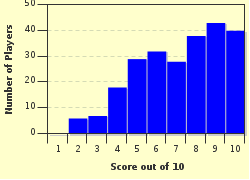Quiz Answer Key and Fun Facts
1. Sometimes timing is everything! On April 6, 1957, "Round and Round" by Perry Como was Number One but poised at Number Two was a doo-wop song that would become perhaps the best remembered of the genre. That same week, an Elvis Presley song debuted on the Top 100 chart with a bullet, hit the top a week later and consigned our doo-wopper to Number Two for seven more painful weeks! Presley's hit was "All Shook Up" but what was its victim? It opened with a mélange of cowbells and castanets before the lead singer broke in with "ahhhhhhhh-yi-yi-yai-yai-ya". Okay, maybe another hint would be helpful... it was recorded by The Diamonds!
2. In 1955, a song by one of those harmonizing male quartets popular at the time stagnated at Number Two on the Top 100 for six weeks. Here are a couple of lines that opened this gem.
"The New Year's Eve we did the town
The day we tore the goal posts down"
What hit was it?
3. An iconic figure in the early days of Rock & Roll was another artist who could never deliver a Number One hit on Billboard's Top 100/Hot 100 charts. His biggest hit stalled at Number Two in America for four weeks (it did hit the top of the U.K. charts) in the winter of 1957-8. Based on the following lyric sample, what song was it?
"Kiss me, baby, oh, it feels good
Hold me, baby, I want to love you like a lover should.
You're fine, so kind
I'm gonna tell the world that you're mine, mine, mine, mine"
4. "You can knock me down, step on my face
Slander my name all over the place"
These two lines come from a Billboard Number Two song in 1956. Yes or no, was Elvis Presley the artist who took it there?
5. In early 1957, a song with the accompanying lyric spent three weeks at Number Two on the Top 100.
"The wind in the willow played love's sweet melody
But all of those vows we made were never to be"
It was unable to dislodge one of the biggest hits of the 1950s, a song that spent ten weeks atop the Billboard chart, "Singing the Blues" by Guy Mitchell. What hit was it?
6. "There goes my baby with someone new
She sure looks happy, I sure am blue
She was my baby till he stepped in
Goodbye to romance that might have been"
This stanza is from a song that spent four weeks at Number Two on the Billboard Top 100 chart in 1957. Which one?
7. "They're really rockin' in Boston, in Pittsburgh, P.A.
Deep in the heart of Texas and 'round the Frisco Bay
All over St. Louis and down in New Orleans"
I'm sure you recognize the words from this hit that spent three weeks at Number Two on the Top 100 Billboard chart in 1958 but can you recall the song's title?
8. A song from the movies raced up the Hot 100 charts in 1956 before hitting a wall in the form of Elvis' mammoth double sided hit "Don't Be Cruel/Hound Dog". It would remain at Number Two for three weeks but successfully reached Number One in the U.K. What was that hit featuring these lines?
"When I was just a little girl
I asked my mother, 'What will I be?
Will I be pretty, will I be rich?'"
9. A Number Two Billboard hit song in 1956, Number One in the U.K., had the unique distinction of being composed in a prison cell. Can you identify it with assistance from this slice of the lyric?
"People come to windows, they always stare at me
Shake their heads in sorrow saying 'Who can that fool be?'"
10. In 1955, a MOR pop song made its first charting appearance on the Top 100 Billboard chart, a big Number Two hit. But, it wasn't done just yet! An R&B version charted in 1961 and a decade later, it reappeared as a contemporary rocker in a big way - Number Four on the Hot 100 but Number One in the U.K. Here's some of the lyric to help you out. What song was it?
"I begged you not to go, but you said goodbye
And now you're telling me all your lies"
Source: Author
maddogrick16
This quiz was reviewed by FunTrivia editor
agony before going online.
Any errors found in FunTrivia content are routinely corrected through our feedback system.

